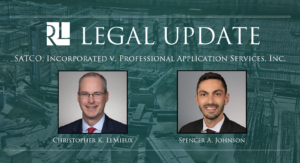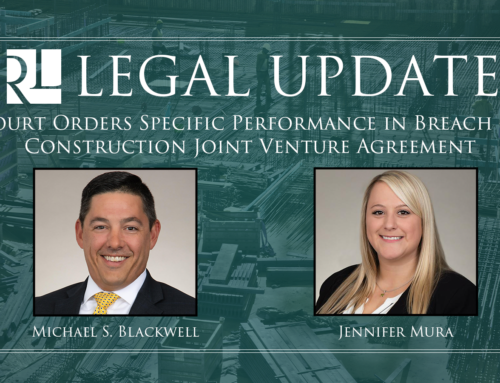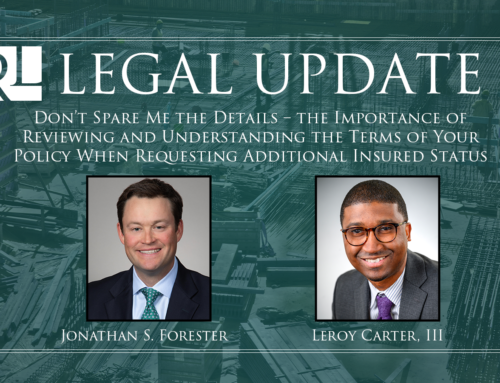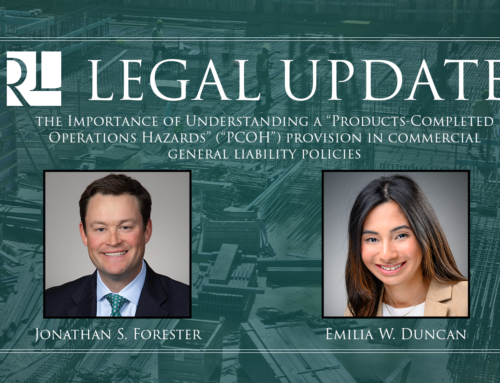 The Louisiana First Circuit Again Holds a Payment Bond Surety Liable Despite Release of Lien Bond Filing, Following its Recent Decision in L&A Contracting Co. v. State Through Dep’t of Transp. & Dev.
The Louisiana First Circuit Again Holds a Payment Bond Surety Liable Despite Release of Lien Bond Filing, Following its Recent Decision in L&A Contracting Co. v. State Through Dep’t of Transp. & Dev.
Authors: Christopher K. LeMieux and Spencer A. Johnson
SATCO, Incorporated v. Professional Application Services, Inc., 23-12 (La. App. 1 Cir. 10/19/23), ___ So. 3d ___, 2023 WL 6889533, considers a similar scenario to that addressed by the First Circuit Court of Appeal in L&A Contracting Company v. State of Louisiana, et.al., 22-1301 (La. App. 1 Cir. 8/16/23), ___ So. 3d ___, 2023 WL 5281846, which involved a public works project with the Louisiana Department of Transportation and Development. Riess LeMieux recently posted an article discussing the Louisiana First Circuit Court of Appeal’s ruling in L&A Contracting, where the First Circuit found that even when a release of lien bond is filed to cancel a statement of claim, the payment bond surety for the project can still be liable for a supplier’s nonpayment. See Riess LeMieux’s post discussing L&A Contracting in further detail at https://rllaw.com/2023/08/31/legal-update-50/.
In SATCO, Incorporated, the First Circuit again considered the liability of a statutory payment bond surety following the filing of a release of lien bond and subsequent cancellation of the lien. This dispute arose out of a public works project for the City of Baton Rouge and Parish of East Baton Rouge (“City/Parish”). The City/Parish entered into a contract with NCMC, LLC (“NCMC”) to perform certain construction services for the project. Under the Louisiana Public Works Act, La. R.S. 38:2241, et seq. (“LPWA”), whenever a public entity enters a contract in excess of twenty-five thousand dollars per project, the public entity shall require that the contractor obtain a surety bond in a sum of not less than fifty percent of the contract price for the payment by the contractor or subcontractor to claimants as defined in the LWPA. La. R.S. 2241(A)(2). Accordingly, NCMC obtained a payment bond from Suretec Insurance Company (“Suretec”) in favor of the City/Parish (the “Statutory Payment Bond”). NCMC subcontracted with Professional Application Services, Inc. (“PASI”) who then sub-subcontracted with SATCO, Incorporated (“SATCO”) for the performance of construction services and labor on the project.
A payment dispute arose between PASI and SATCO, which resulted in SATCO filing a lien against NCMC’s payment bond in the mortgage records for East Baton Rouge Parish and shortly thereafter filing suit. SATCO voluntarily cancelled its first lien and subsequently filed a second lien claim, which ultimately became the focus of the Court. In response, PASI obtained a release of lien bond (“ROL Bond”) from U.S. Fire Insurance Company (“UFSI”) guaranteeing payment of SATCO’s lien claim, and the Clerk and Recorder of Mortgages for the Parish cancelled SATCO’s lien. Suretec subsequently filed exceptions of no cause of action and no right of action arguing that, as a result of the filing of the ROL Bond and cancellation of SATCO’s lien claim, Suretec was no longer liable to SATCO under the Statutory Payment Bond issued by Suretec.
The First Circuit, in deciding whether the Statutory Payment Bond was still in effect following the filing of the ROL Bond, discussed the purpose of the LPWA as follows:
Statutes like the … LWPA are intended to protect laborers and suppliers of materials on public works and [] this objective is accomplished by requiring a statutory payment bond, which serves as an additional fund or security to assure that those who perform work on public projects receive payment for their work in the event of a contractor’s inability to fulfill its payment obligations, thereby insuring against unpaid claims from parties supplying labor and materials for the construction of public works.
Bearing in mind this purpose, the First Circuit looked to the provisions of La. R.S. 38:2247, which provides that “[n]othing in [the LPWA] shall be construed to deprive any claimant, as defined in [the LPWA] and who has complied with the notice and recordation requirements of R.S. 38:2242(B), of his right of action on the bond furnished pursuant to [the LPWA].” Considering the purpose of the LPWA and the plain language of the statute, the First Circuit concluded that La. R.S. 38:2247 referred to the statutorily required payment bond rather than the bond described in La. R.S. 38:2242.2(A), which optionally allows an “interested party” to cancel a claimant’s lien.
Therefore, the First Circuit held that the filing of the ROL Bond and subsequent cancellation of SATCO’s lien claim by the recorder of mortgages did not release Suretec from its statutory bond obligations to SATCO. Under the holdings in SATCO, Incorporated and L&A Contracting, if a release of lien bond is filed on a public works project, material suppliers and those claimants not in privity with the general contractor are effectively given two separate avenues for potential recovery of unpaid amounts, i.e., the statutory bond, or the ROL Bond. On the other hand, it also creates a scenario where the two sureties will likely fight over which is forced to satisfy any judgment that the claimant may obtain.



